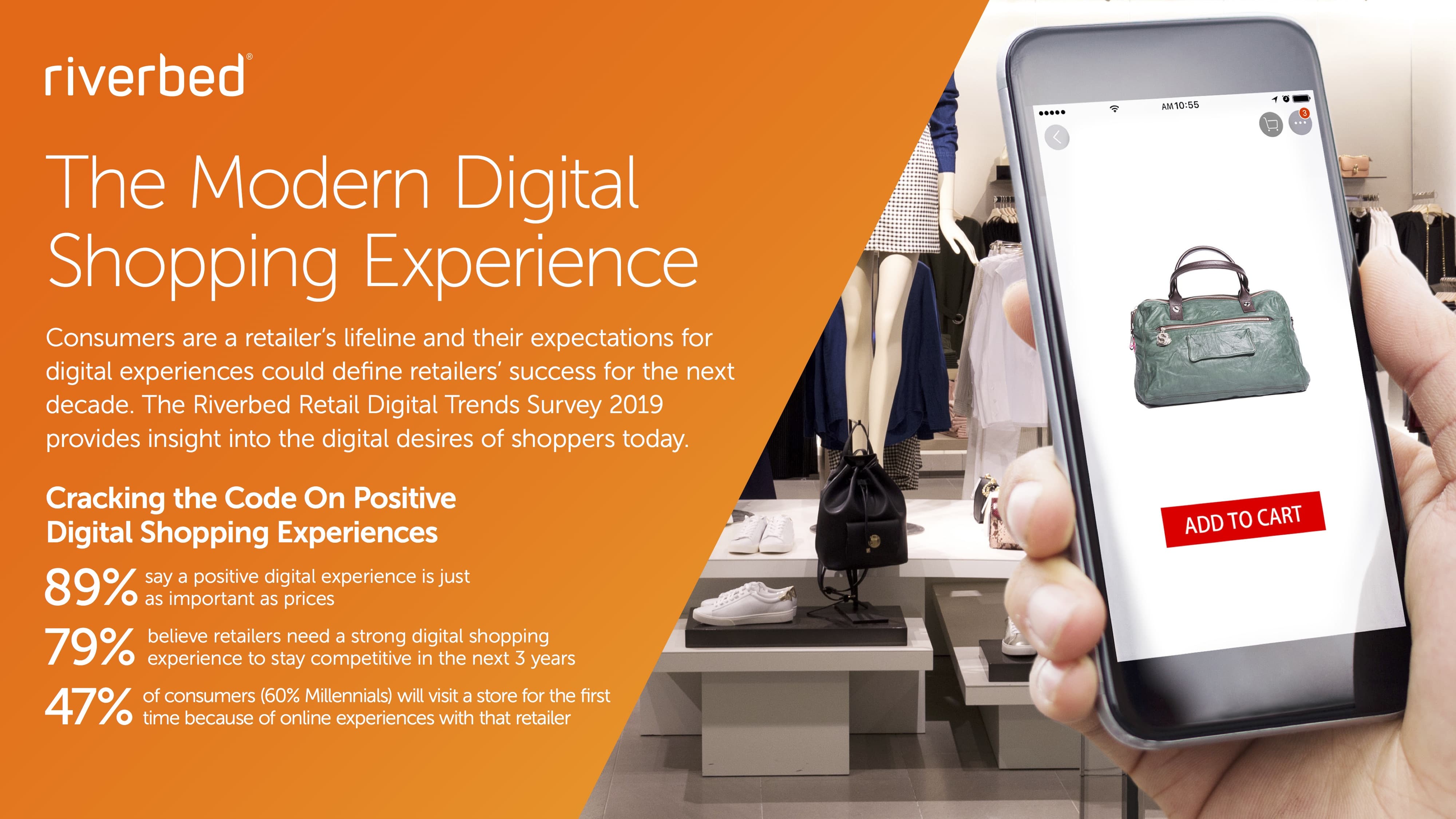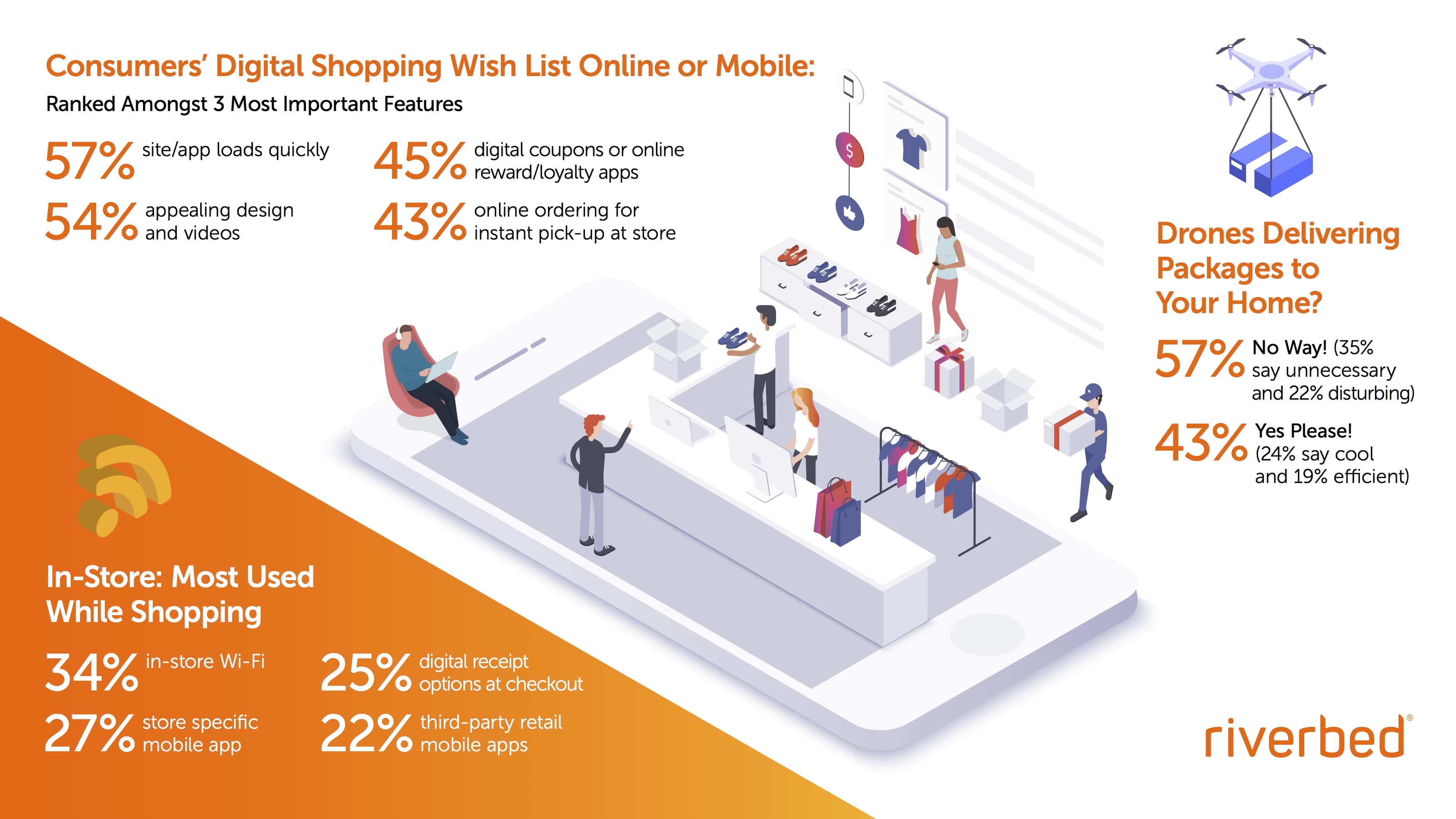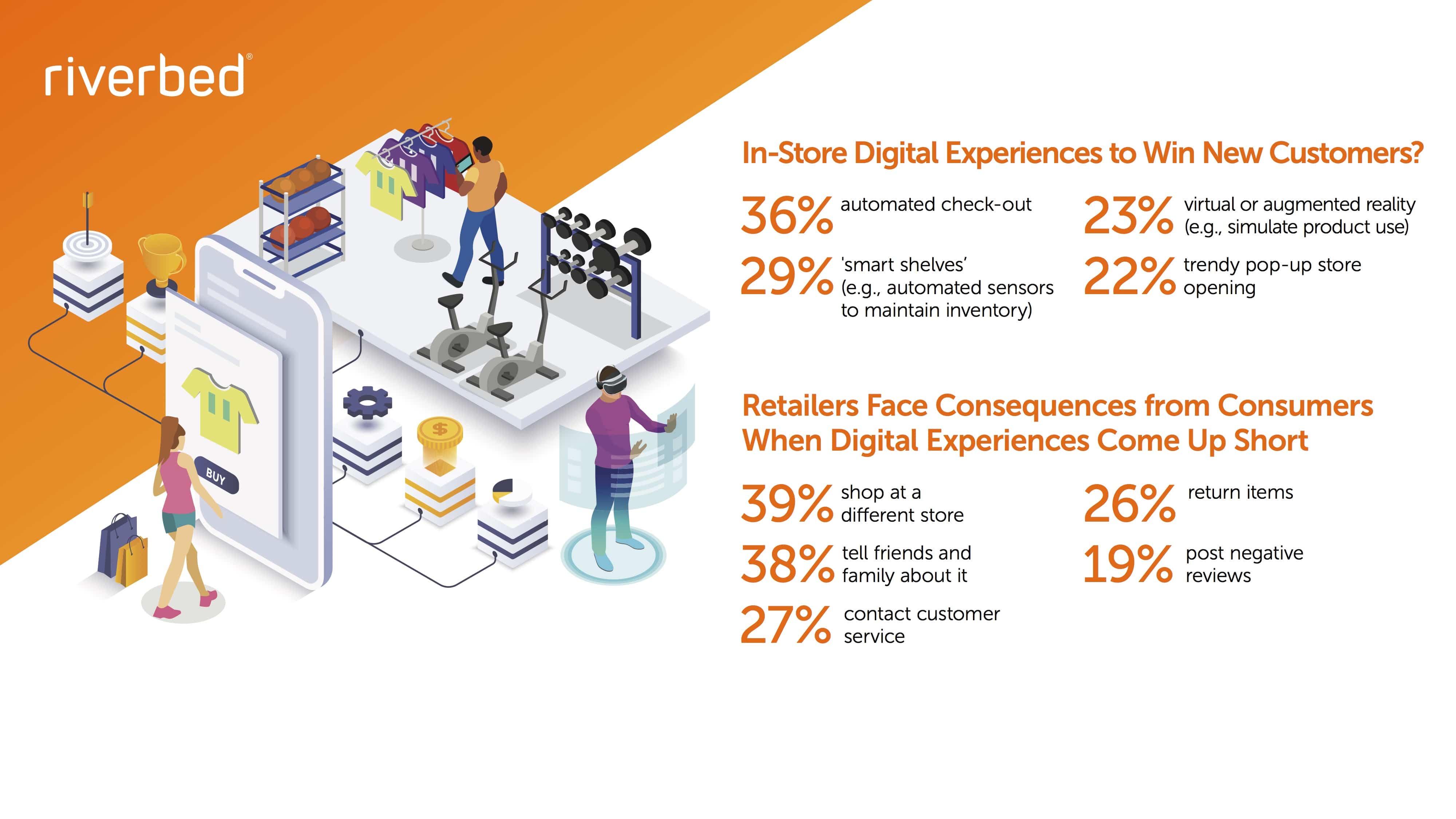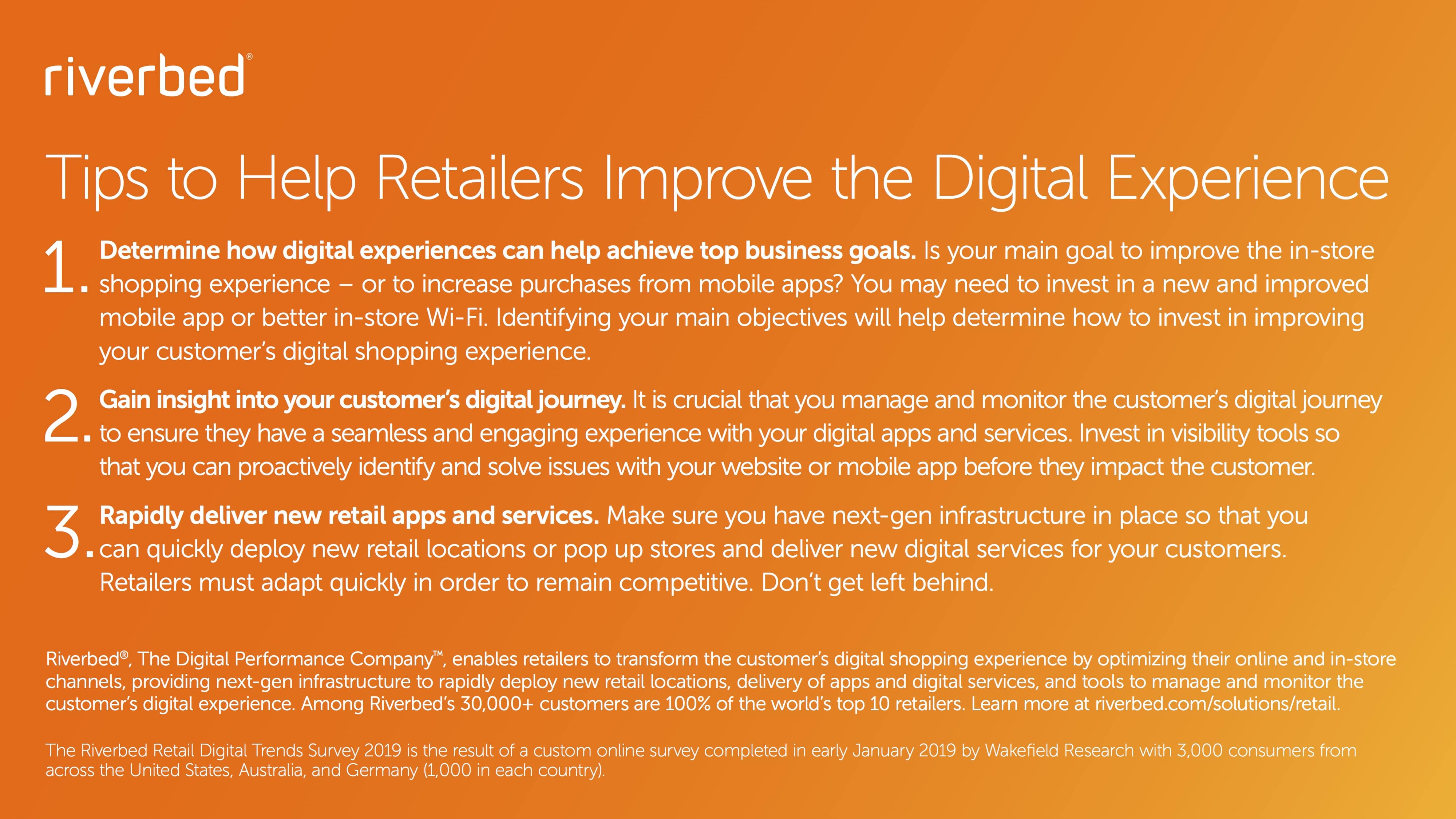New research from digital performance firm Riverbed explores insights and perspectives of consumer opinions on the digital retail experience—and what they desire from retailers to stay engaged, satisfied and loyal. The firm’s report, Riverbed Retail Digital Trends Survey 2019, based on a global survey of 3,000 consumers from across the U.S., Australia and Germany, reveals that brick-and-mortar retailers are more apt to grow and maintain a loyal customer base if they invest in the digital experience they offer shoppers, both online and in-store.
A vast majority (89 percent) of respondents say a positive digital shopping experience impacts brand loyalty just as much as their prices, and 79 percent believe brick-and-mortar retailers have a short, three-year window to provide shoppers with strong digital experiences in order to remain competitive—significantly higher than what retailers said in Riverbed’s survey last year, with 47 percent of retailers believing they only have three years to deliver a compelling digital shopping experience to stay competitive.
“This study reveals that it’s essential to provide consumers with engaging online and in-store digital experiences if brick-and-mortar retailers want to remain relevant—or risk losing their business,” said Subbu Iyer, SVP and CMO of Riverbed Technology, in a news release. “This doesn’t mean retailers must invest in every new technology that comes along, but they do need to find the sweet spot that lives at the intersection of technology and consumer expectations, as well as having the underlying infrastructure to support these digital initiatives and ability to measure and manage the customer’s digital experience.”
Brick-and-mortar retailers can reboot with new digital experience strategy
One of the biggest problems brick-and-mortar retailers face today is declining foot traffic, which is driving closures of physical stores. However, brick-and-mortar retailers have a huge opportunity to attract new customers to their stores, as 47 percent of consumers say they have specifically visited a store for the first time because of the enjoyable online digital experience that the brand provided. And that number jumps to 60 percent for Millennial shoppers, and 57 percent for German consumers.
As you might expect, when consumers were asked to rank the three most important online features, the ability for sites/apps to load quickly (57 percent) is considered most important, followed by an appealing design including photos/videos (54 percent). The next most important online features include:
- 45 percent – Digital coupons, online rewards, and loyalty apps
- 43 percent – Ability to shop online and pick-up instantly in-store
- 40 percent – Access to consumer reviews
- 36 percent – Quick access to customer service via chat
- 25 percent – Interactive features that allow consumers to design or customize outfits, room designs, etc.
The 360-degree digital experience consumers want from retailers
The digital experience for consumers doesn’t start and end online, as consumers want brick-and-mortar retailers to offer in-store digital services and features that enhance the overall shopping experience. The most popular digital offerings that consumers typically take advantage of while shopping in-store include in-store Wi-Fi (34 percent), using a store-specific mobile app (27 percent), opting for digital receipts via email at check-out (25 percent), and using third-party mobile apps for things like digital coupons, discounts or price comparison shopping (22 percent). Using ordering kiosks and in-store virtual assistants rated lower at 14 percent.
However, getting consumers in the door for the first time will require investing in new digital technologies or spaces. Sixty-eight percent of consumers surveyed said at least one of the following digital or in-store experiences would appeal to them enough to shop at a brick-and-mortar store for the first time:
- 36 percent – Automated checkout sans sales associate
- 29 percent – “Smart” shelves with automatic sensors that maintain inventory
- 23 percent – Virtual or augmented reality
- 22 percent – Opening a “pop up” shop in a high traffic location
There are also a number of geographical differences. For example, in the U.S., automated checkouts came in at 44 percent; in Germany, ‘smart shelves’ ranked highest at 33 percent; and Australians at 27 percent, are more likely than American or German consumers to shop for the first time at a retailer as a result of a pop-up store.
Man vs. machine to influence retail wars
While the idea of drone delivery continues to make headlines, many consumers have split and differing opinions about it. While 43 percent are positive on drone delivery (24 percent say it’s cool and 19 percent think the concept is efficient), 57 percent are not (35 percent feel it’s just unnecessary and 22 percent think it’s disturbing). However, 55 percent of millennials are positive on drone delivery, with 31 percent saying it’s cool, and 25 percent efficient.
For shoppers to be happier in-store it looks like, over time, retailers will need to provide less, not more, human interaction. While, overall, 85 percent say they would like to interact with humans rather than technology at least for part of the shopping experience, the picture starts to shift when it comes down to specifics. For returns or help finding items in-store, half or 50 percent of consumers want to interact with humans and the others with technology. However, for making a purchase and getting shopping recommendations (or fashion advice), 63 percent and 67 percent respectively, would prefer to interact with technology versus humans. And of the consumers surveyed, 15 percent even said there is nothing they would rather interact with a human than a chatbot.
Retailers beware—deliver a poor digital experience and consequences will follow
There is nothing worse than an unhappy customer, and 71 percent of shoppers that had poor digital shopping experiences have taken some form of action as a result:
- 39 percent – Decided to shop at a different store
- 38 percent – Told family and friends about the negative experience
- 27 percent – Contacted customer service with feedback
- 26 percent – Returned an item they had purchased
- 19 percent – Posted negative reviews online
U.S. consumers at 77 percent are most likely to take some action for a poor digital shopping experience, versus consumers in Germany (69 percent) and Australia (67 percent).
And while consumers want great digital experiences, they are very much on the fence when it comes to stores using their personal data to deliver a more customized experience. A slight majority (54 percent) prefer not to sacrifice their personal data and receive a less tailored service, while 46 percent are willing to give up data for a more personalized experience.
The Riverbed Retail Digital Trends Survey 2019 is the result of a custom online survey completed in early January 2019 by Wakefield Research with 3,000 consumers from across the United States, Australia, and Germany (1,000 in each country). Riverbed, headquartered in San Francisco, enables retailers to transform the customer’s digital shopping experience by optimizing their online and in-store channels, providing next-gen infrastructure to rapidly deploy new retail locations and the delivery of apps and digital services, and tools to manage and monitor the customer’s digital experience. Among Riverbed’s 30,000+ customers are 100% of the world’s Top 10 retailers.












